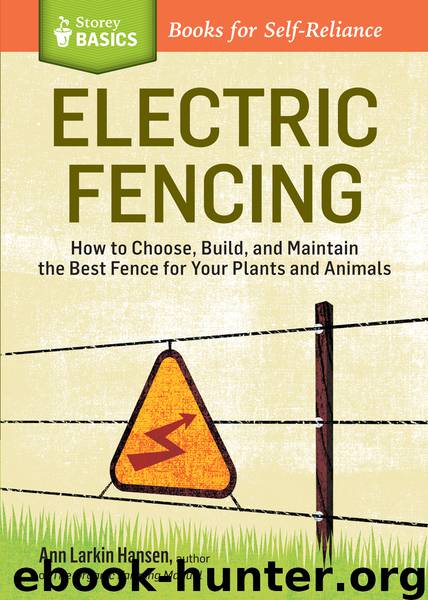Electric Fencing by Ann Larkin Hansen

Author:Ann Larkin Hansen
Language: eng
Format: epub
Tags: livestock, fence, fencing, fencing for livestock, fencing for animals, electric fencing, protect chickens, protect beehives, protect, protection from predators, protect from wildlife, installing fence, maintenance, grazing, farm, farmer, protect crops, portable, portable electric fencing, successful rotational grazing, Storey Basics Series, farmland
Publisher: Storey Publishing, LLC
Published: 2013-07-10T16:00:00+00:00
Types of Braces
Install braces at the corners and ends of any permanent fence where the wire is pulled tight. An H-brace takes the most time and materials to build, but is the most reliable. A floating brace or a diagonal brace works well when there are fewer wires and less tension.
H-brace
Floating brace
Diagonal brace
Installing Line Posts
The line posts in traditional physical fences are typically placed 8 to 10 feet (2.4 m) apart. This spacing can vary considerably by locale, though, and may depend on whether the wire is heavy or light (posts for barbwire fences out West are often much farther apart). Permanent electric-only fenceposts can be spaced 20 feet (6 m) or even farther apart, the only limiting factor being how much wire sag you’re willing to put up with.
The easiest way to get a straight fenceline is to put in the corner posts first, then stretch twine (baling twine works great) or wire from corner to corner, and install the posts along the wire. To measure the correct distance between the posts you can use a tape measure, a measured length of board or PVC pipe, or, if you’re not very fussy (though I am), just pace it off.
Download
This site does not store any files on its server. We only index and link to content provided by other sites. Please contact the content providers to delete copyright contents if any and email us, we'll remove relevant links or contents immediately.
The Body: A Guide for Occupants by Bill Bryson(4978)
Audition by Ryu Murakami(4855)
Adulting by Kelly Williams Brown(4491)
Housekeeping by Marilynne Robinson(4349)
Be in a Treehouse by Pete Nelson(3956)
1578 Plant Pattern Recognition Receptors by Unknown(3944)
Zero Waste Home by Bea Johnson(3782)
Seriously... I'm Kidding by Ellen DeGeneres(3578)
Better Homes and Gardens New Cookbook by Better Homes & Gardens(3531)
The Healing Self by Deepak Chopra(3478)
Barkskins by Annie Proulx(3314)
Hedgerow by John Wright(3280)
The Cellar by Natasha Preston(3265)
Spark Joy by Marie Kondo(3253)
The Genius of Japanese Carpentry by Azby Brown(3228)
The Life-Changing Magic Of Tidying Up- The Japanese Art Of Decluttering And Organizing (v5.0) by Marie Kondo(3216)
120 Days of Sodom by Marquis de Sade(3185)
Work Clean by Dan Charnas(3055)
The Book of Numbers by Peter Bentley(2913)
